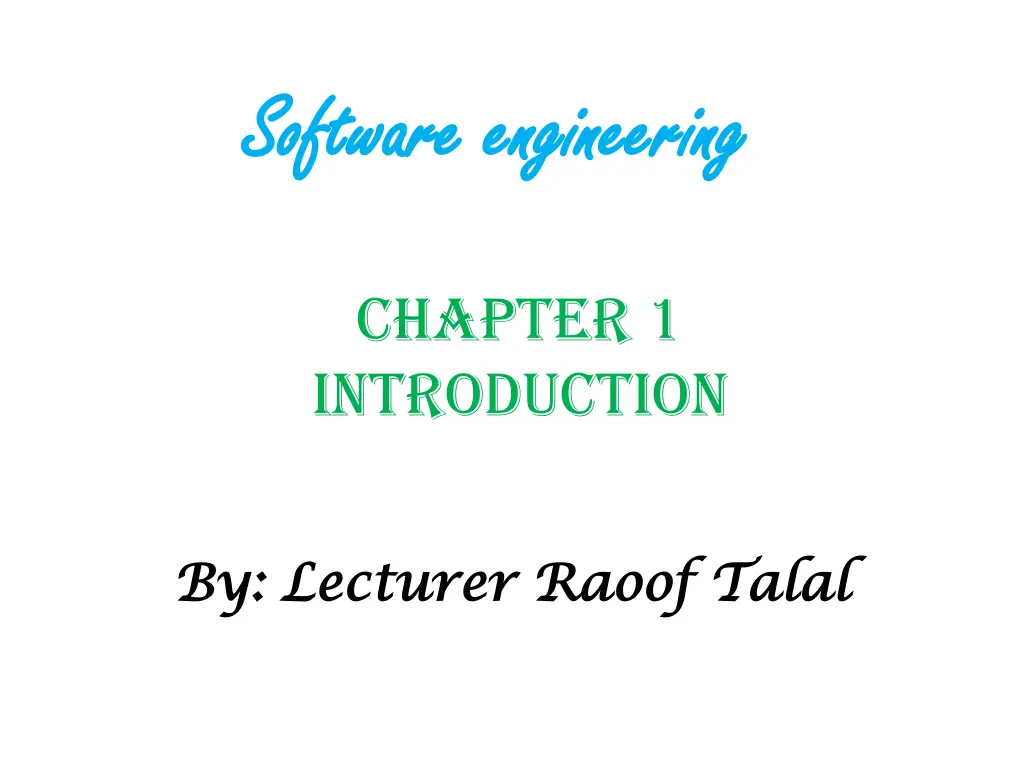
Understanding Software Engineering: Importance and Applications
Explore the world of software engineering and its crucial role in modern society. Learn about the significance of software systems, the role of software engineers, and the different aspects of software production and maintenance. Discover how software engineering impacts various industries and enables technological advancements.
Download Presentation

Please find below an Image/Link to download the presentation.
The content on the website is provided AS IS for your information and personal use only. It may not be sold, licensed, or shared on other websites without obtaining consent from the author. If you encounter any issues during the download, it is possible that the publisher has removed the file from their server.
You are allowed to download the files provided on this website for personal or commercial use, subject to the condition that they are used lawfully. All files are the property of their respective owners.
The content on the website is provided AS IS for your information and personal use only. It may not be sold, licensed, or shared on other websites without obtaining consent from the author.
E N D
Presentation Transcript
Software engineering Software engineering Chapter 1 introduction By: Lecturer By: Lecturer Raoof Raoof Talal Talal
1-1 Introduction We can t run the modern world without software. National infrastructures and utilities are controlled by computer-based systems and most electrical products include a computer and controlling software. There are many different types of software systems, from simple embedded systems to complex, worldwide information systems.
Software engineers can be rightly proud of their achievements. Of course we still have problems developing complex software but, without software engineering, we would not have explored space, would not have the Internet or modern telecommunications.
Many people think that software is simply another word for computer programs. However, when we are talking about software engineering, software is not just the programs themselves but also all associated documentation and configuration data that is required to make these programs operate correctly.
A professionally developed software system is often more than a single program. The system usually consists of a number of separate programs and configuration files that are used to set up these programs. It may include system documentation, which describes the structure of the system; user documentation, which explains how to use the system, and websites for users to download recent product information.
1-2 Software Software is Computer programs and associated documentation. Software products may be developed for a particular customer or may be developed for a general market.
1-3 Software Engineering Software engineering is an engineering discipline that is concerned with all aspects of software production from the early stages of system specification through to maintaining the system after it has gone into use. Software engineers are concerned with developing software products (i.e., software which can be sold to a customer). There are two kinds of software products:
1. Generic products: These are stand-alone systems that are produced by a development organization and sold on the open market to any customer who is able to buy them. Examples of this type of product include software for PCs such as databases, word processors, drawing packages, and project-management tools. It also includes so-called vertical applications designed for some specific purpose such as library information systems, accounting systems, or systems for maintaining dental records.
2. Customized products: These are systems that are produced to a particular customer. A software contractor develops the software especially for that customer. Examples of this type of software include control systems for electronic devices, systems written to support a particular business process, and air traffic control systems.
1-4 Essential Attributes of Good Software Maintainability: Software should be written in such a way so that it can evolve to meet the changing needs of customers. This is a critical attribute because software change is an inevitable requirement of a changing business environment. Dependability and security: Software dependability includes a range of characteristics including reliability, security, and safety. Dependable software should not cause physical or economic damage in the event of system failure. Malicious users should not be able to access or damage the system.
Efficiency: Software should not make wasteful use of system resources such as memory and processor cycles. Efficiency therefore includes responsiveness, processing time, memory utilization, etc. Acceptability: Software must be acceptable to the type of users for which it is designed. This means that it must be understandable, usable, and compatible with other systems that they use.
1-5 Software Process The systematic approach that is used in software engineering is sometimes called a software process. A software process is a sequence of activities that leads to the production of a software product. There are four fundamental activities that are common to all software processes. These activities are:
1.Softwarespecification: where customers and engineers define the software that is to be produced and the constraints on its operation. 2.Softwaredevelopment:where the software is designed and programmed. 3.Software validation: where the software is checked to ensure that it is what the customer requires. 4.Software evolution: where the software is modified to reflect changing customer and market requirements.






















